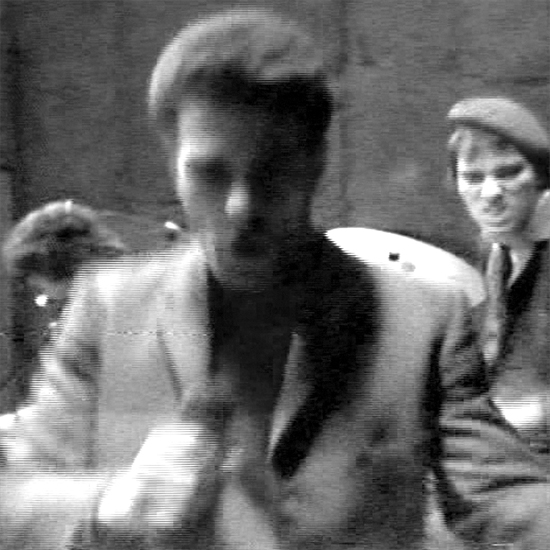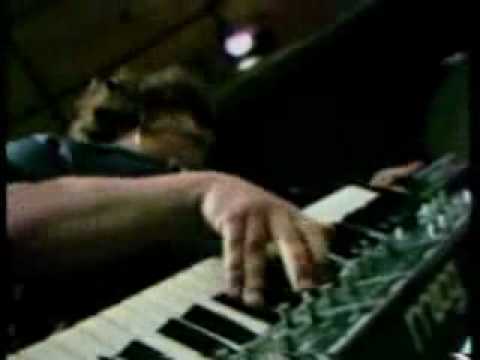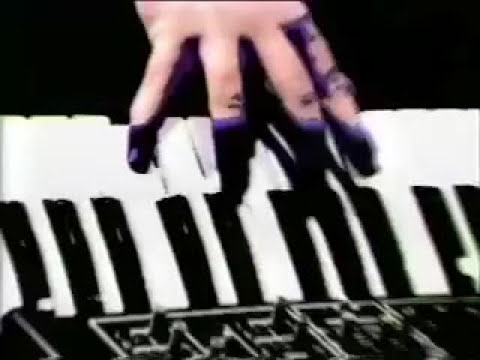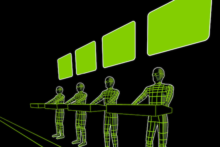I first heard Futurisk on a mixtape given to me by a friend. The song was ‘Army Now’. I remember hearing that song for the first time, and immediately being struck by the raw synth sounds and hand-played melodies in combination with the live drumming. This new wave/punk crossover was ingenious. I began hunting for more Futurisk stuff and soon acquired a copy of the Player Piano 7" EP from a guy in Florida named Anthony, who got his copy from Errol (Jeremy Kolosine’s brother) when they were in 9th grade. The stamp on the 7" said "Deerfield Beach, Florida", which was an interesting reference for me since I had been there when I was 12 and didn’t recall any of this sort of music. After doing some light research, I discovered that Jeremy Kolosine was still musically active, doing chipmusic in bands 8-Bit Operators and Receptors. I wrote him telling him I was a huge fan and proposed a Futurisk release on Minimal Wave. He dug up some unreleased studio recordings from 1982 that had been engineered by Mike Couzzi, who did some pretty big stuff in the 80s. One of the tracks was ‘Meteoright’, which I ended up licensing for my second compilation The Found Tapes (A Compilation of Minimal Wave from North America ’81-’87). That was released in 2007. We stayed in touch, and then in 2009, Jeremy drove up to NYC with the studio reels to lend me to have transferred. That meeting spurred the release of the Player Piano LP (Minimal Wave) in 2010 and the Lonely Streets Remixes EP (Cititrax) in 2011.
How old were you when you decided to form Futurisk and what inspired the name?
Jeremy Kolosine: When I was 17 I started recording more seriously at home. That was when I wrote and recorded a solo version of ‘Army Now’ with just guitar and a drum machine. Me and my Deerfield Beach High School friend Frank Lardino formed a mostly punk covers band called Art Decadence, kinda named after the second track on side two of Bowie’s Low [‘Art Decade’]. That band broke up and when I was 18 I started doing solo synth-guitar/drum machine shows (a sort of poor man’s Frippertronics) as Clark Humphrey and Futurisk. Clark Humphrey represented the human masculine emotional element (name taken from Clark Gable and Humphrey Bogart) and Futurisk representing the unpredictable yet emotionless mechanical element of the music. Though I had the name Futurisk floating around in my head for a while it was an also an homage to the Futurist Manifestos which I had discovered because it was the only title you could read on the bookshelf on the cover of Fripp & Eno’s (No Pussyfooting) original gatefold album sleeve. After I won some money in an original music performance competition in 1979, I used it to go in the studio with Frank and Jack Howard to record the first vinyl 45 of ‘Army Now’ and just went with the name Futurisk for the band.
Tell us a bit about your childhood. How did your move from London to South Florida affect your late teen aspirations?
JK: I was born in Hackney, London in 1960 and my family moved to South Florida in late 1973, a couple of years before the British punk movement started, so the punk I was most affected by was the original well of inspiration, American punk. In the UK I saw my first concert with my older brother Ron, which was Bowie’s last tour with the Spiders [From Mars] for the Aladdin Sane album. We saw the first show on that tour at Earl’s Court in 1973 when I was 12. It blew my mind, as did all the albums my brother would bring home, like the first two Roxy Music albums. Prior to that I had gotten into synth music pretty young. My parents were always very supportive of my interest in the arts, and my mom brought me to the store to get a Stylophone which I saw on the Rolf Harris show, but the salesmen talked us out of it and into a Phillips portable cassette player that I brought with me everywhere to show off because no one else I knew had one yet. When I was 11 I got Rick Wakeman’s The Six Wives of Henry VIII and Emerson, Lake and Palmer’s Tarkus. But once I heard Bowie the glam thing took over, except I still liked King Crimson and Peter Gabriel’s Genesis, as well as anything remotely related to Eno, Roxy and Bowie.
At that time being able to get hold of a synth seemed far-fetched for a teenager so I just wrote songs on guitar and wasn’t that great a player. I was a pretty good artist and illustrator for my age so I had thoughts I might pursue that avenue. My brother was a hair stylist so I was always the youngest kid with new haircuts, first a Rod Stewart cut, but then the classic Bowie cut. When we moved to the US I was beyond weird to almost everyone, seeing as I was wearing girl’s clothes and odd hair while everyone else was into southern rock, long hair and jeans. For the first few years I got into a few fist fights because people would always be asking me if I was a boy or a girl. Looking back at those teen years in S. Fla, I think they forced me to be completely ambivalent to any outside criticism and praise alike. Doing this kind of music in such an unfitting place (at the time) you had to literally not give a damn what anyone thought of it or your artistic soul would perish.
What synths did you use and who played what? Were there other South Florida bands with similar style?
JK: It was me playing the Sequential Circuits Pro One and Casios, Ritchie (Richard Hess) playing Minimoog and Roland string machine (before synth polyphony was available we put it or a Casio through the Moog filter for ‘Trans-Europe Express’-like strings, trying to get that Orchestron sound which can be heard on the 1st version of ‘Lonely Streets’), while Jack (Howard) played Syndrums along with the real drum kit. The drum machines used were the TR-606 and BOSS Dr. Rhythm DR-55. In the later live shows we used the Roland Microcomposer, the TB-303 and the 808. Once midi became available Ritchie used the Prophet 600 too. In the early days of Futurisk I used the Electro-Harmonix Guitar Microsynth and the EH Rhythm 12 beatbox, Frank used the Korg MS-10 and before Ritchie had a Moog he used a couple of KATs (famous for being used to communicate with dolphins). We also used a Roland SVC-350 Vocoder, usually through the Minimoog.
As far as Florida bands went, there were a couple using synths but more in the experimental noise realm, like Happiness Boys (who were nice guys too). Richard Bone played around Miami here and there but I guess he was from New York and went back, plus he was not really part of punk or the new wave. The only other synth wave band would have to be Radio Berlin (no relation to the Vancouver act), but that band was just the remnants of the 1st pre-1981 Futurisk live members that I split with after we got on each other’s nerves.
Who were your influences (individually and collectively)?
JK: Luckily we were all pretty much into the same stuff, mostly innovative music from 1972 to 1982. We were influenced by anything Bowie and Eno had anything to do with, like early Ultravox! and Iggy Pop’s The Idiot album, and of course Roxy Music’s first three albums, Sex Pistols’ Bollocks and Wire. In the prog rock realm I was still into King Crimson, especially the Red album, and early Genesis, especially The Lamb Lies Down On Broadway. Then the first three Peter Gabriel albums and Steve Hillage’s Gong, Robert Calvert and Hawkwind, 1970’s electronics like Kraftwerk and The Residents and anything Conny Plank touched. From the punk and new wave it was Pere Ubu, Devo, Talking Heads, PiL, XTC, early Psychedelic Furs, early Blondie and No Wave artists like James Chance & the Contortions/James White & the Blacks and DNA. Then, when The Normal/Daniel Miller’s ‘TVOD’ and ‘Warm Leatherette’ came out, along with Depeche Mode’s Speak & Spell, the first Human League albums and especially John Foxx’s Metamatic, it changed everything.
Those albums showed how ex-punks could do music like Kraftwerk without being embarrassed about the naivety of the wonderment of amateurish discovery. Kraftwerk’s Computer World was such sheer perfection it seemed unattainable at the time to compete with anything like that, but Metamatic was so raw and sparse yet so riveting. It was somewhere between those two albums that we strived to land musically and production-wise. In Futurisk you can hear all those influences somehow, whereas most of the electronic music at the time projected a cold human-automaton image and sound. We had that too, but the emotive human elements were unfiltered and the gut feelings were left in, I guess more like Suicide did. In this way I suppose we were more electro-punk but the Bryan Ferry and Foxx romanticism and fashion sense also remained.
How did you get your music out to the public? Tell us about your approach to releasing it. Did you play live? Who were your fans?
JK: My first Clark Humphrey & Futurisk solo shows started in early 1979. It was me running a drum machine through an Electro-Harmonix Microsynth then adding guitar. The first show ever was at my brother Ron’s fashion/hair show Imagery in the Round, and my piece was called ‘A Complex Of Rhythms’ – I still have the flyer. I performed ‘Complex’ several times throughout the year at various venues to befuddled receptions, since I would also sit in the audience as it played.
After the ‘Army Now’ single came out in 1980, the band got lots of gigs and press due to the fact that there was only one other local vinyl released at the time that was considered punk or new wave, other than The Eat’s ‘Communist Radio’ 45. So releasing the vinyl ourselves was a key decision in cementing our place in the footnote of Florida musical history. When ‘Army Now’ sold out within months (I pressed 500 copies), I decided we should do an EP and press 1000 copies, and that was the Player Piano EP which also sold out, and brought with it a slew of press, shows and video offers. Both vinyls sold out entirely through consignment at local record stores like Peaches and Open Records, which was a bit of a music hub at the time. I just drove from Miami to Palm Beach and hit all the major stores and left them handfuls of each of the records. We were super serious about flyer campaigns. We read the Futurist Manifestos and tried to copy their approach tongue-in-cheek, such as their manifestos of ‘The Art Of Buffoonery’ and ‘The Pleasure Of Being Booed’, just trying to create general mayhem by posting thousands of flyers in odd places. I had access to free printing so we went nuts. If you lived in Fort Lauderdale at that time, you saw Futurisk flyers stapled to every lamp post for miles. Jack even yelled a maniacal ‘Futurisk scream’ at the top of his lungs every time he posted them, so people thought we just insane I guess.
Futurisk received quite a bit of local press, and you were even featured on the Ed Rich Rock Show. How did you guys handle all this at the time? How did the public describe your music?
JK: At the time the main frame of reference the general public had was Gary Numan’s ‘Cars’ and other songs that maybe had a Syndrum crack on it, or some songs by The Cars. When the Human League’s Dare, Soft Cell’s ‘Tainted Love’ and Devo’s ‘Whip It’ hit too, things got less one dimensional in the descriptions given. We encouraged writers just to use the the word ‘electropop’ since that’s what it was, but sometimes other silly names were used to describe it like ‘Bleep’ and such. The term ‘electro-punk’ was used by one reviewer at the time and we used the term on a couple of flyers for shows we knew we playing that were less dance oriented, where there would be a punk crowd. And the term ‘minimalist’ was used often. As always, lazier critics would just use comparisons to other songs by bands that were popular at the time for five minutes, but the more initiated knew to at least compare it to Kraftwerk and Depeche Mode or Devo, or Eno’s Roxy.
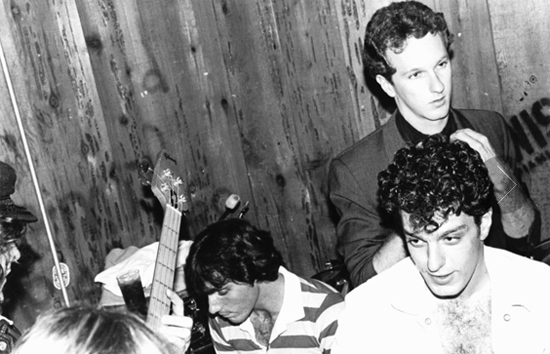
It’s funny looking back how new it all seemed to most people, and many were ambivalent towards drum machines and synths, especially, it seems in most US markets at the time. The West Coast was really the only region that seemed to embrace it slightly, with bands like The Units and The Screamers and Chrome, and Our Daughter’s Wedding, I think due to The Residents’ presence out there, and some pockets of groups in places like Akron, and there was Suicide in NYC. But even NYC was so totally immersed in the guitar wave that I think the synth support was negligible. The overtly macho stance of most punk music left most of those supporters feeling out of place at an electronic show, except for the more intelligent and explorative fans, in my opinion. Everyone wanted to be part of some rock gang again, and electronic had none, so only the most individually minded, like Devo fans, would get it that the gang ideal was all part of the scam and uniform.
Did you ever imagine that artists would be remixing your material in 2011? When did the initial resurgence of interest begin and how has it affected you?
JK: It pretty much blows my mind really. I hid this light under the proverbial bushel for so long thinking it had had its run, and at the same time a little embarrassed of the naivety inherent in the words and some of the music. It was fulfilling to realize that we were on to something longer lasting after all. I’ve never stopped making music and it’s always incorporated a lot of electronics. In my mind I’m still using the same approach and artistic ideals I did back then. In some ways it’s a form of arrested development, I guess. It’s a joy to contact the old bandmates and inform them of new development regarding work we buried 30 years ago, and I know for a fact it has helped all of us psychologically to know that people that weren’t even born till the 90s, in many cases, are getting into what we were doing and even citing us as an influence. In many ways it’s due to the internet and its eternal bank of knowledge, so I feel that it might not have happened without the internet and discophiles on eBay paying ridiculous prices for so-called lost gems.
It’s in this way that think the term ‘minimal wave’ as a genre developed too. It’s like certain pockets of formerly ignored self-released rhythm & blues being termed ‘Northern Soul’ in the 70s by DJs who discovered those tracks, or the original blues guys that no one heard of being touted by early-mid 60s UK rock bands. But in this case it was driven by thousands of individuals searching for lost vinyl that none of their online peers had discovered yet, As far as well-established artists like James Murphy and Chris Carter showing Futurisk respect like they have, well, that is just mind-boggling to me and instills even further the sentiment that one should never give up and especially never be anything but yourself.
Visit the Futurisk page on the Minimal Wave website

